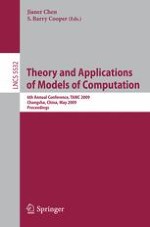This book constitutes the refereed proceedings of the 6th International Conference on Theory and Applications of Models of Computation, TAMC 2009, held in Changsha, China in May 2009. The 39 full papers presented together with 7 invited papers as well as 3 plenary talks were selected from 86 submissions. The papers address the three main themes of the conference which were Computability, Complexity, and Algorithms. The conference aimed to bring together researchers with interests in theoretical computer science, algorithmic mathematics, and applications to the physical sciences.
